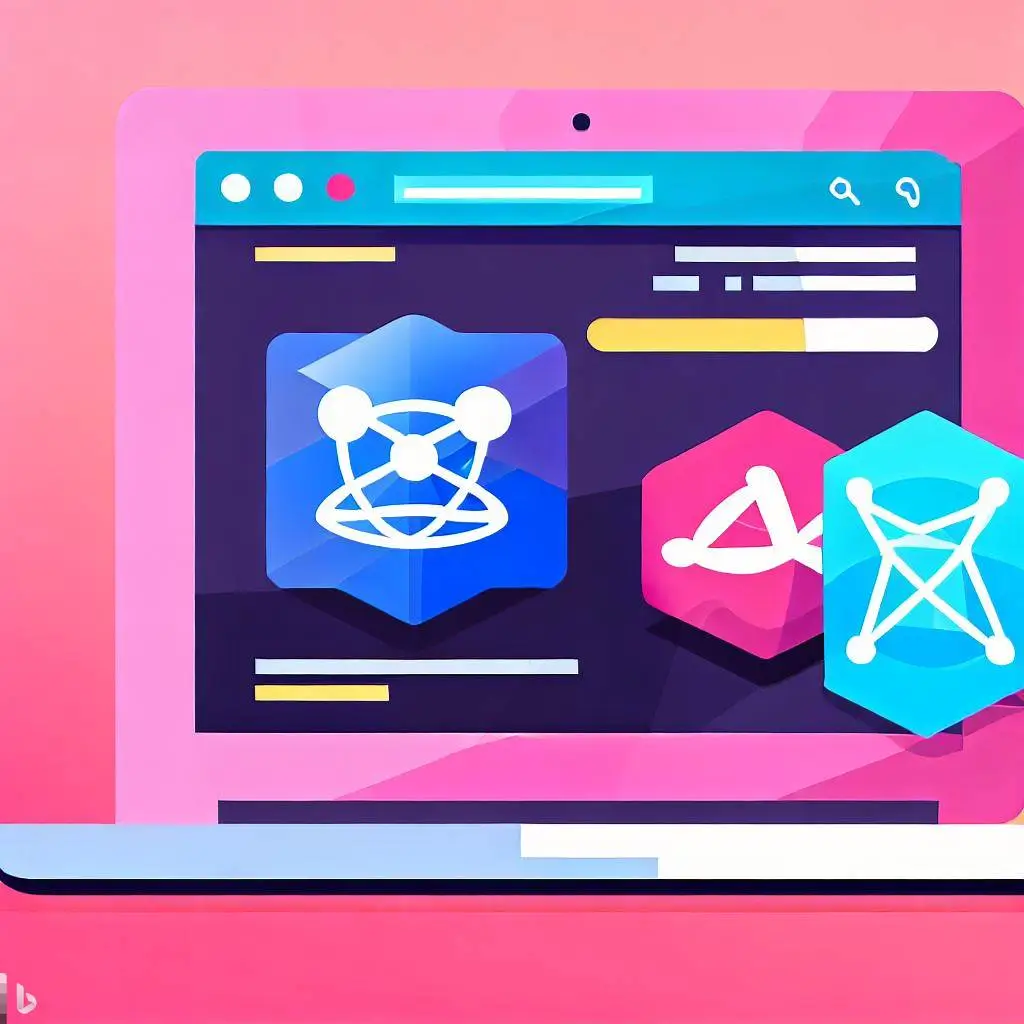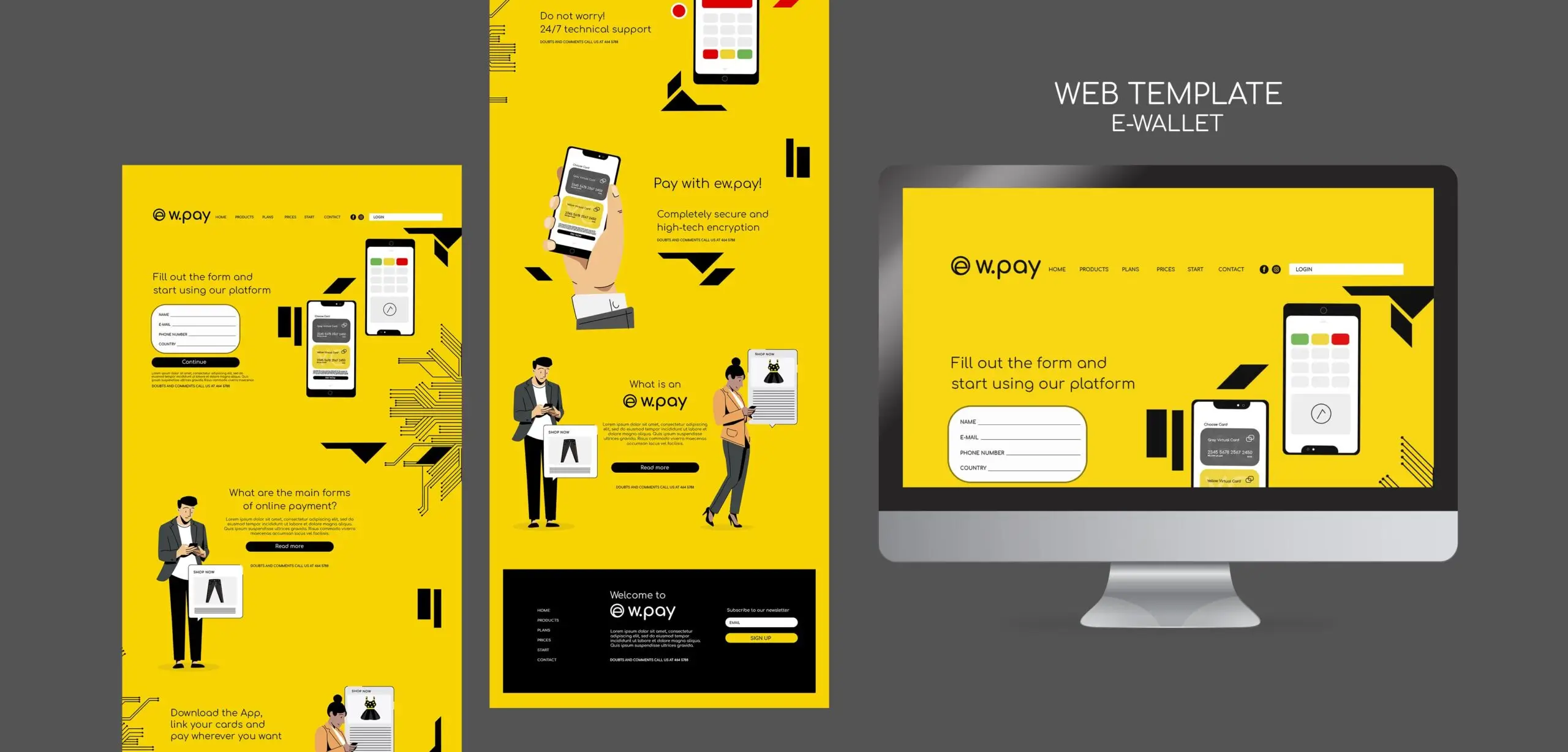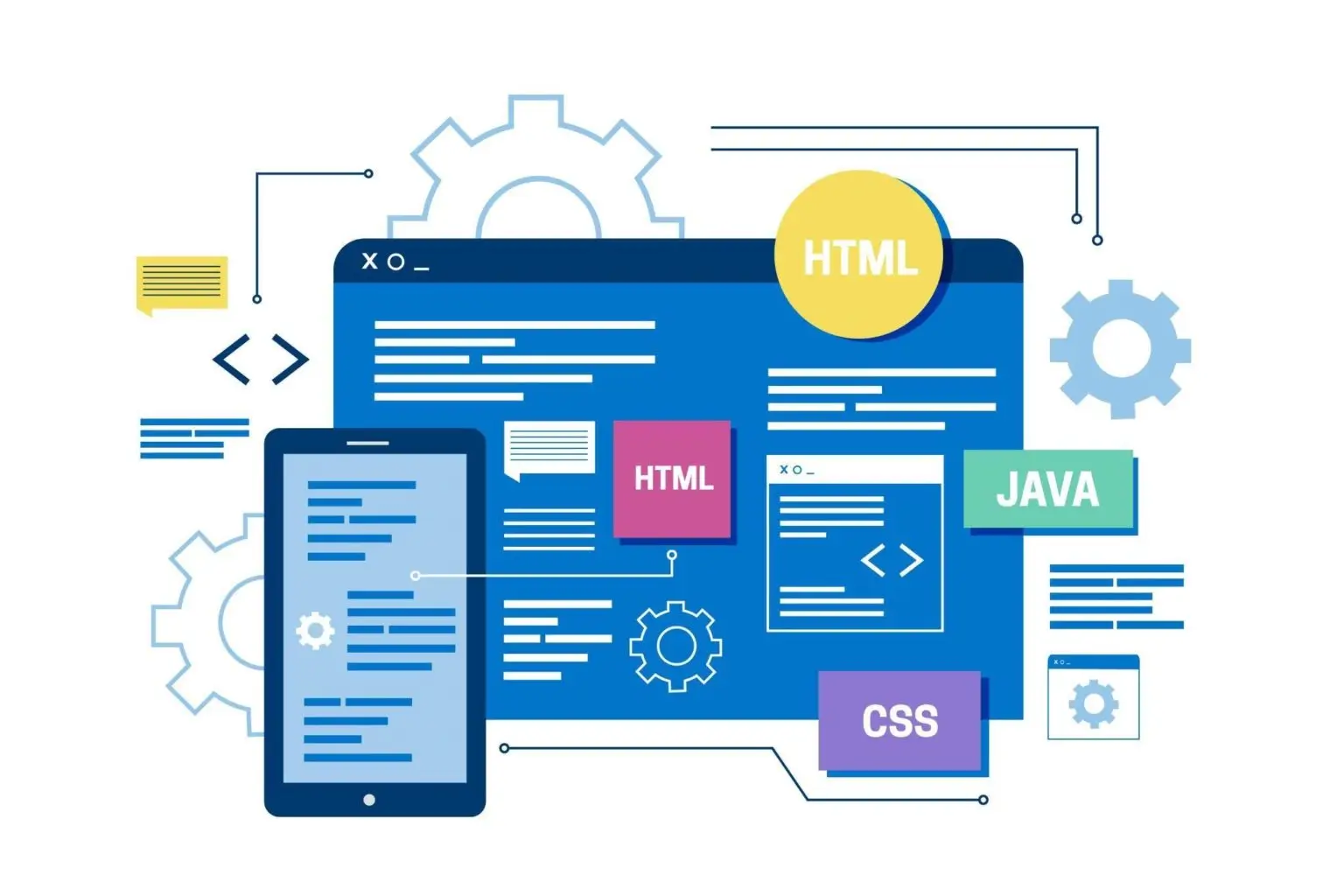Front-end web development is an ever-evolving field that requires developers to stay up-to-date with the latest techniques and best practices. As a beginner web developer, it’s essential to learn the basics of HTML, CSS, and JavaScript. But as you gain experience, you’ll need to develop more advanced skills to build modern web applications that are responsive, interactive, and visually appealing.
In this article, we’ll explore advanced development techniques that can help you take your front-end development skills to the next level. Whether you’re an experienced developer looking to improve your skills or a beginner web developer looking to expand your knowledge, these techniques can help you build better web applications. If you’re just starting with front-end development, it’s essential to learn the basics of HTML, CSS, and JavaScript. You can check out the essential guide for front-end development to get started. Once you have a solid foundation, you can start exploring advanced techniques to create more dynamic and interactive web applications.
Front-end web development is the practice of creating the visual and interactive elements of a web application. It involves using HTML, CSS, and JavaScript to create responsive websites that work on different devices. To take your front-end development skills to the next level, you need to master advanced techniques for each of these languages. If you’re looking to build a modern and responsive web application, it’s essential to hire experienced front-end developers who have the skills and expertise needed to create custom solutions that meet your unique business needs. A team of experienced front-end developers usually has a deep understanding of HTML, CSS, and JavaScript, as well as other front-end frameworks and digital marketing techniques. We can help you build a web application that not only looks great but also performs well and meets your business goals

HTML is the foundation of every web page, and advanced techniques can help you create more dynamic and interactive web applications. Here are some advanced techniques for HTML:
Semantic HTML uses specific tags to describe the content’s meaning rather than just its appearance. This makes it easier for search engines and screen readers to understand the content and improves accessibility.
The HTML5 Canvas element allows you to create dynamic graphics and animations using JavaScript. This technique is useful for creating interactive games, data visualizations, and other dynamic content.
Web Components allow you to create reusable custom elements that can be used across different web applications. This technique can improve code organization and reduce development time.
CSS is used to style and layout web pages and advanced techniques can help you create more responsive and visually appealing designs. Here are some advanced techniques for CSS:
CSS Grid and Flexbox are layout systems that allow you to create complex layouts with ease. These techniques are useful for creating responsive designs that adapt to different screen sizes.
CSS Animations and Transitions allow you to add dynamic effects to your web pages without using JavaScript. These techniques can improve user engagement and create a more immersive experience.
Responsive Web Design is a technique that allows you to create web pages that adapt to different screen sizes. This technique is essential for creating mobile-friendly web applications that work on different devices.

JavaScript is used to add interactivity and dynamic functionality to web pages, and advanced techniques can help you create more complex applications. Here are some advanced techniques for JavaScript:
Asynchronous JavaScript allows you to execute code without blocking the main thread, which can improve performance and user experience.
JavaScript libraries and frameworks like React, Angular, and Vue.js can help you build more complex web applications with ease.
Debugging and performance optimization are critical skills for any front-end developer. Advanced techniques like profiling and code splitting can help you identify and fix performance issues in your web applications.
Full-stack development involves working on both the front-end and back-end of a web application. To become a full-stack web developer, you need to master both front-end and back-end development skills. Here are some advanced techniques for full-stack development:
Back-end development languages like Node.js, Python, Ruby on Rails, and PHP are essential for building full-stack web applications.
Databases like MySQL, PostgreSQL, MongoDB, and Redis are essential for storing data in full-stack web applications.
APIs (Application Programming Interfaces) allow different software applications to communicate and interact with each other. Understanding how to work with APIs is crucial for building full-stack web applications.
Technical skills are essential for any front-end developer looking to advance their career. Here are some technical skills that can help you take your front-end development skills to the next level:
Version control systems like Git are essential for collaborating with other developers on projects.
Understanding how to use the command line interface (CLI) can help you automate tasks and improve your workflow.
Testing your code is crucial for ensuring that it works correctly. Advanced testing techniques like unit testing and integration testing can help you catch bugs before they become problems.
Taking online courses is an excellent way to improve your front-end development skills. Here are some online courses that can help you take your skills to the next level:

Front-end frameworks like React, Angular, and Vue.js can help you build complex web applications with ease. Here are some advanced techniques for working with front-end frameworks:
Server-side rendering (SSR) can improve the performance of your web application by rendering pages on the server instead of the client.
APIs (Application Programming Interfaces) allow different software applications to communicate and interact with each other. As a front-end developer, understanding advanced techniques for working with APIs can greatly enhance your ability to build robust and seamless web applications. Here are some advanced techniques for APIs:
Implementing secure authentication and authorization mechanisms is crucial when working with APIs. Techniques such as OAuth 2.0 and JSON Web Tokens (JWT) can help you ensure that only authorized users can access protected resources.
To prevent abuse and ensure fair usage of APIs, rate limiting and throttling techniques can be implemented. These techniques help control the number of requests a client can make within a certain time frame, preventing excessive usage and maintaining API performance.
Caching API responses can significantly improve the performance of your web application. By storing frequently accessed data locally, you can reduce the number of API calls and minimize response times. Techniques like HTTP caching headers and client-side caching can be employed to optimize API usage.
Robust error handling is essential when working with APIs. Advanced techniques include implementing proper error codes, handling different types of errors gracefully, and providing meaningful error messages to users. Additionally, building fault-tolerant systems that can handle temporary API failures or network issues is crucial for maintaining a seamless user experience.
When dealing with large datasets from APIs, pagination and filtering techniques come in handy. Pagination allows you to retrieve data in smaller, manageable chunks, while filtering enables you to retrieve specific subsets of data based on certain criteria. These techniques improve performance and provide users with more targeted results.
Webhooks enable real-time communication between systems by sending HTTP requests from one application to another based on specific events or triggers. Leveraging webhooks allows you to build integrations that respond instantly to external events, enhancing the functionality and versatility of your web application.
In conclusion, advancing your front-end development skills is essential to keep up with the ever-evolving field of web development. By mastering advanced techniques in HTML, CSS, and JavaScript, you can create more dynamic and interactive web applications. Additionally, learning full-stack development skills, technical skills, and digital marketing techniques can further enhance your abilities as a front-end developer. Taking online courses and working with front-end frameworks can also help you stay up-to-date with the latest technologies. Lastly, understanding advanced techniques for working with APIs is crucial for building robust and seamless web applications. By continuously learning and exploring new technologies, you can build modern web applications that meet the demands of today’s users.
The languages and skills used to create the user interface form the basis of front-end web development. Designers who possess these fundamental abilities can create websites that are both aesthetically pleasing and extremely functional. Because users access websites using such a wide range of devices, today’s dynamic digital environment places a premium on responsive web design and interactive features. The right front-end development technology must be chosen as a result. Whether you are a novice web developer or a seasoned front-end developer, this article will assist you in selecting the best technological stack for your specific knowledge and experience.
Front-end web developers are the architects of the digital world. They create the visual elements, interactive features, and responsive designs that users encounter on websites and web applications. These professionals possess a unique skill set that combines technical prowess with creative flair. In this article, we will explore the essential skills and knowledge areas that define a successful front-end developer.

Front-end development requires a solid understanding of HTML, CSS, and JavaScript. Modern, feature-rich websites are constructed using these languages as their foundation.
Websites are built on the Hypertext Markup Language (HTML) standard, which defines how they should be organized and what content should be displayed. By defining elements like headings, paragraphs, images, and links, it lays the semantic framework for websites.
The look and behavior of a website are controlled by Cascading Style Sheets (CSS). By changing attributes like color, font, spacing, and responsiveness, designers can alter how HTML elements appear. Understanding CSS coding is essential if you want to create appealing and adaptable designs.
JavaScript is a scripting language that makes it possible to create interactive features and layouts, giving web pages a new lease on life. JavaScript allows for real-time communication with web servers, the generation of dynamic content, and the processing of user input without requiring a page reload.
Both junior and senior developers are essential to the front-end development process. They collaborate closely with full-stack developers and designers to create a consistent and user-friendly user interface (UI) for desktop and mobile platforms. It’s worth noting that user-friendly designs play a crucial role in front-end development. A well-designed UI can significantly impact the success of a website or application. The influence of user-friendly websites is for those seeking to enhance their knowledge of the importance of user-friendly designs. It provides valuable insights into the integration of user-friendly designs into the development process, resulting in exceptional user experiences. It highlights the critical role of user-friendly designs and their significance in achieving success.
Before diving into the confusing world of front-end development technologies, it’s crucial to assess your experience and knowledge. To create mobile-friendly, highly optimized websites, front-end developers must have a firm grasp of HTML, CSS, and JavaScript.
Analyze your level of familiarity with the web languages used in the front end of websites. You’re able to write Java, CSS, or HTML code. Understanding your strengths and weaknesses is crucial. The first step in determining which technology stack will best suit your needs is to take a sincere assessment of your own strengths and weaknesses.
Which CMSs (Content Management Systems) have you used before? Platform-specific requirements for sites created with WordPress, Drupal, and Joomla include things like template customization and plugin development. Any front-end developer who wants to work on CMS-based projects must become an expert in the field of content management systems. While CMSs are an essential aspect of web development, choosing the right one can be challenging. Check out Choosing Right CMS for your website if you’re considering building a website using a CMS

When choosing front-end technology, the following points should be taken into consideration:
Your project’s requirements and objectives should guide your choice of technology. CMSs and custom web applications might be technologically distinct from one another. Consider the cost of the supplies and equipment you’ll be using. Check to see if your project necessitates the creation of responsive websites. You should also think about whether image optimization is required and whether you have access to the resources and methods for effective image handling if you want to make sure that pages load quickly.
Consider how well your chosen front-end technology integrates with the other tools and frameworks you’ll be employing during development. Compatibility issues with backend systems, unit testing, or developer tools in your browser may have an impact on how effectively your workflow operates. Knowing how your chosen technology fits into the bigger picture is important because front-end and back-end engineers frequently collaborate to ensure smooth data exchange and integration.
There is a constant need for front-end developers with advanced technical skills in a variety of languages and frameworks. To find out which technologies are in demand, it’s a good idea to keep up with the labor market. The potential for increased earnings and job opportunities can be achieved by acquiring marketable technical skills.

Let’s examine some of the front-end innovations that are currently most in demand:
Have you explored essential front-end development strategies and skills? If you’re looking to enhance your knowledge further, I encourage you to read my blog post, “Front-End Development Strategies and Skills: The Essential Guide”. It provides valuable insights into the key skills every front-end developer should possess.
Before making any technological choices, it is essential to match your skills and goals with the requirements of your project. You might want to research CSS preprocessors and postprocessors if you are proficient in CSS and if you want to advance your knowledge of aesthetic design. If this is crucial for your project, think about using a responsive web design framework like Foundation or Bootstrap.
You should also pay attention to the design of your project. You’ll be able to make wise design choices and develop user-friendly interfaces if you have a solid grasp of UI and UX design principles.
Front-end development requires ongoing learning and skill development due to the field’s constant evolution. Both technical knowledge and soft skills, like the capacity for effective collaboration and communication, are crucial. It is simpler to stay current with trends and best practices in front-end development by networking with other developers.
For websites to function flawlessly and to be responsive, front-end web developers are essential. These specialists act as the link between design and development, ensuring the flawless implementation of complex user interfaces. In order to debug and correct source code errors and produce the highest-quality result possible, they make use of browser developer tools.
It’s essential for any programmer to select the best front-end development technology. Front-end programming languages and the basics of web development are the only way to create superior user experiences. The technology you use should be appropriate for your level of expertise, the project’s requirements, and your career objectives. Understanding market trends, conducting a thorough self-evaluation, and being committed to lifelong learning are all necessary for navigating the dynamic front-end development landscape successfully. A strong technology stack is critical to your success in the constantly evolving field of web development, whether you’re a junior developer just getting started or a senior front-end developer looking to expand your knowledge.
In today’s fast-paced digital landscape, ensuring the optimal performance and security of your website is more critical than ever. Monitoring websites has evolved from a best practice to an absolute necessity, not only for maintaining a seamless user experience but also for safeguarding against critical vulnerabilities and cyber threats. In this comprehensive guide, we will delve into the essential tools, techniques, and key features that empower you to achieve constant uptime monitoring, government-grade security checks, and frictionless experiences for your users.
The internet is a bustling marketplace where millions of websites vie for attention. In this highly competitive landscape, user experience is everything. Websites that perform sluggishly or suffer frequent downtime quickly lose visitors and potential customers. Additionally, the threat of cyberattacks and data breaches looms large, making security monitoring equally crucial.
Website monitoring is the proactive stance against these challenges. By regularly assessing the performance and security of your website, you gain insights into its health and can take preventive measures before issues escalate.
Website monitoring goes beyond mere usability and touches on critical aspects that define your online presence:
Usability issues can deter users and negatively impact the customer experience. Website monitoring tools assess user interfaces, ensuring that your site provides seamless and frictionless experiences.
The importance of website monitoring extends to security teams and the security community. Regular security assessments, including government-grade security checks, are crucial for identifying and addressing critical vulnerabilities before they can be exploited. Your site’s reputation and user trust depend on robust security measures.

Effective performance monitoring is foundational to delivering a stellar user experience:
Employing a full-time Security Admin is essential for maintaining robust security measures. This dedicated role ensures continuous vigilance against cyber security weaknesses, performing security assessments and taking proactive measures.
Achieving constant uptime monitoring is facilitated by synthetic monitoring systems and domain monitoring tools. These tools not only assess your website’s uptime but also monitor critical components like FTP servers and domain expiry dates.
Monitoring tools offer latency tests and customizable thresholds to detect latency issues before they impact the end-user experience. Customizable performance thresholds allow you to set specific criteria for acceptable performance, ensuring that deviations trigger alerts.
Real-time notifications provide instant alerts, enabling you to respond promptly to performance issues. Monitoring tools offer a detailed interface that provides key insights into performance metrics, load error rates, and technical issues, allowing you to make informed decisions and optimizations.
In an era of frequent cyber threats, security monitoring is paramount. Websites can fall victim to various attacks, including malware injections, DDoS attacks, and data breaches. Without adequate security measures, your website and user data are at risk.
The development of secured websites is an essential component of effective security monitoring. Building a strong security foundation starts during the development phase, where security considerations are woven into the very fabric of your website’s architecture. This involves employing secure coding practices, regularly updating software components, and conducting thorough security assessments during development.

Secured websites are less vulnerable to attacks, making the job of security monitoring more manageable and effective. When your website is built with security in mind, it acts as a robust fortress against cyber threats. This proactive approach not only safeguards your digital assets but also enhances user trust and confidence in your online presence.
Protecting your website and user data requires a multifaceted security approach:
Security monitoring encompasses a range of advanced features, including advanced monitors, Core Web Vitals assessments, and basic monitors. These features help identify cyber security weaknesses and areas of improvement, ensuring your site remains secure against evolving threats.
Infrastructure monitoring is comprehensive, covering multiple geographic locations to detect negative impacts on performance. By assessing server locations, actual users’ experiences, and real browser tests, you gain a holistic view of your website’s performance and security posture.
Instant alerts are a lifeline for security and performance issues. They empower you to take immediate action, mitigating potential damage and minimizing disruptions for your users.
APM and RUM provide in-depth insights into response times, application performance, and the end-user experience. These tools help you pinpoint bottlenecks and areas of improvement in real-time.
Synthetic monitoring is a proactive technique that emulates real user interactions with your website. It involves the use of monitoring locations distributed worldwide to simulate actual users’ experiences. By conducting synthetic monitoring, you can proactively detect and address performance and security issues before they impact your users, ensuring a seamless and secure browsing experience.
Monitoring websites for performance and security is no longer optional; it’s a fundamental practice for delivering a seamless user experience while safeguarding your digital assets. This encompasses usability assessments, constant uptime monitoring, government-grade security checks, and the ability to identify and mitigate critical vulnerabilities. By harnessing advanced monitoring tools, techniques, and key features, you empower your website to operate optimally, providing users with frictionless experiences while staying resilient against ever-evolving cyber threats. Embrace the power of website monitoring, and you’ll not only thrive in the digital landscape but also build trust and loyalty among your users. Your website’s success hinges on your commitment to continuous monitoring and enhancement.
By entrusting your website to the care of professionals well-versed in monitoring techniques and strategies, you ensure that every facet of your site’s performance and security is meticulously examined. These experts not only conduct usability assessments and constant uptime monitoring but also engage in government-grade security checks with the precision of a cybersecurity team.
Moreover, professional website monitoring goes beyond automated scans; it involves a dedicated Security Admin and a vigilant security community that collaboratively assesses and addresses cybersecurity weaknesses. This level of attention ensures that your site’s defenses are always one step ahead of potential threats.
Modern web design now demands the use of responsive website templates. Being able to adjust your website to different screen sizes and resolutions is essential because more and more people are using mobile devices to access the internet. A pre-designed layout that adapts to fit the screen of any device is known as a responsive website template. The advantages of adopting responsive website templates will be discussed in this post, along with the top 10 templates that may be used by any type of company.
A web design strategy called responsive design seeks to offer the best viewing experience possible on a variety of devices. A pre-built design that is responsively optimized is known as a responsive website template. Instead of needing to develop unique versions of websites for each device, it enables web designers to create websites that can adjust to various screen sizes and resolutions.
Responsive website templates leverage modern technologies and intuitive interfaces to provide a flawless user experience. They often come with custom plugins and a range of features that make it easy to create a visually appealing and functional website. With the responsive layout provided by these templates, your website will look beautiful on any device. For those who are unfamiliar with responsive websites, there is a guide available on responsive web design that provides a comprehensive explanation of how it works and its importance in modern web design. By checking out this guide, you can gain a better understanding of responsive websites and their benefits.

When selecting a responsive website template, it’s important to consider various factors to ensure it meets your business needs. Here are some essential criteria to keep in mind:
Look for templates with these features. A visually appealing website will make a positive impression on visitors.
Select a template that is mobile-friendly to ensure that users on mobile devices have a seamless experience. This ensures that your website works and looks fantastic on tablets and smartphones.
Consider templates with a variety of features, such as contact forms, drop-down menus, and custom plugins. These features improve your website’s usability and user experience.
Customization Options
Pick a template that offers customization options so you can personalize your website and make it consistent with your brand identity. Look for opportunities to alter the typefaces, layouts, and color palette.
Some templates may include advanced features like split-screen sliders or interactive elements. These can give your website a distinctive flair and set it apart from the competition.

Divi is a flexible and adaptable template with modern designs, an intuitive interface, custom plugins, and a range of features. It offers a user-friendly drag-and-drop builder, making it easy to create unique designs.
Avada is a versatile template renowned for its straightforward aesthetic and wide-ranging customizability possibilities. It features a responsive design and is compatible with many modern technologies.
There is a fully adjustable template with a variety of pre-built color schemes and layouts. It has various features suitable for various businesses and offers a responsive design.
Bridge is an innovative website template with beautiful graphics and cutting-edge functionality. It supports modern technologies like parallax scrolling and offers a responsive layout.
X is a flexible template that includes numerous distinctive designs known as “stacks.” Its adaptable design and range of customization possibilities make it suitable for various enterprises.
Jupiter is a versatile template renowned for its simple aesthetic and wide-ranging customizability possibilities. It offers a responsive design and works with cutting-edge programs like CSS3 animations.
Porto is a business website template with modern designs, clean layouts, and a range of features. Due to its adaptable layout and support for individual plugins, it can be used in various sectors.
TheGem is a flexible template with cutting-edge functionality and contemporary designs. It has an adaptable design and supports modern features like video backgrounds and smooth scrolling.
Salient is a robust template with many features, beautiful designs, and cutting-edge functionality. Modern technologies like parallax effects are supported, and it offers a responsive layout.
Uncode is a creative website template known for its simple aesthetic and open-ended customization possibilities. It provides a responsive design and works with modern programs like CSS3 transitions.
Choosing the best responsive website template is crucial for developing a visually appealing and mobile-friendly website, to sum up. When choosing the ideal template for your company, take into account elements like contemporary styles, customization choices, range of functionality, and more sophisticated capabilities. Using these responsive themes can help you ensure that your website offers the best user experience possible across all devices, bringing in more visitors and enhancing your online visibility.
In the dynamic world of full-stack development, acquiring a comprehensive understanding of the best tools and frameworks is pivotal. Full-stack developers are well-equipped professionals who possess a wide range of skills, allowing them to handle both front-end and back-end web development. Their unique skill sets open up diverse career opportunities in the software industry, making them highly sought after. To embark on this promising career path and thrive in it, one must harness the right tools and frameworks that facilitate efficient and seamless full-stack web development.
Front-end development, which deals with the graphical user interface and user interactions, relies on a myriad of tools and frameworks. These are crucial for creating dynamic web applications that engage users effectively. As a full-stack developer, a strong understanding of front-end technologies is essential:
Full-stack developers typically start with code editors like Visual Studio Code, Sublime Text, or Atom. These editors provide an ideal environment for writing and managing code.
Tools like Git and Mercurial are indispensable for tracking changes, collaborating with teams, and maintaining code integrity.
npm (Node Package Manager) and Yarn streamline the process of adding and managing libraries and dependencies.
CSS frameworks such as Bootstrap and Materialize are essential for responsive design, ensuring optimal user experiences across various devices.
JavaScript is the core of front-end development. Libraries like jQuery and frameworks like React, Angular, and Vue.js empower developers to create interactive and user-friendly front-end interfaces.

Back-end development, also known as server-side development, involves managing server logic, databases, and server-side scripting. The Back-end developers, an integral part of full-stack web development, leverage various tools and frameworks:
Full-stack developers choose from a range of programming languages like Python, Node.js, Ruby, and PHP based on project requirements.
Express.js (for Node.js), Ruby on Rails, and Django (for Python) are popular frameworks that expedite back-end development by providing pre-built components and structures.
Tools like MySQL, PostgreSQL, MongoDB, and Firebase offer diverse database options for storing and retrieving data efficiently.
The DevOps practices and collaboration tools play a crucial role in the full-stack development process, ensuring efficient development workflows:
Full-stack developers often employ DevOps practices and tools like Jenkins and Travis CI to implement continuous integration and continuous delivery (CI/CD), streamlining the software development process.
Git for version control, GitHub for code hosting, JIRA for project management, and Slack for team communication to enhance collaboration and project organization.
Full-stack development frameworks are a boon for full-stack web developers as they simplify the development process by offering standardized architectures for both front-end and back-end. These frameworks are particularly invaluable when in the hands of experienced full-stack developers. Their deep understanding of the intricacies of full-stack web development allows them to harness the full potential of these frameworks, optimizing efficiency and ensuring seamless integration. Noteworthy full-stack frameworks include MEAN (MongoDB, Express.js, Angular, Node.js), MERN (MongoDB, Express.js, React, Node.js), and LAMP (Linux, Apache, MySQL, PHP/Python/Perl). These frameworks empower experienced full-stack developers to create robust and scalable web applications, cementing their role as integral assets in the software industry.

Quality assurance is a critical aspect of full-stack development. Full-stack developers employ testing and debugging tools to ensure that web applications perform flawlessly:
Security should never be an afterthought in full-stack development. Tools and best practices are vital to secure web applications and databases:
The growing demand for mobile applications has significantly expanded the horizons of full-stack developers. As users increasingly rely on mobile devices for various tasks, the ability to develop mobile applications has become a valuable skill set. Full-stack developers, with their proficiency in both front-end and back-end development, are well-equipped to enter the realm of mobile app development.
Tools like React Native, Flutter, and Xamarin have revolutionized the landscape of mobile app development. These cross-platform frameworks enable full-stack developers to create mobile applications that work seamlessly on both Android and iOS devices, eliminating the need to develop separate apps for each platform. What’s more, these frameworks allow developers to share a considerable portion of code with their web applications, making the development process more efficient and cost-effective.
Learning mobile app development is an exciting and valuable endeavor for full-stack developers. It opens up new avenues for innovation and career growth while enhancing their skill set. The ability to deliver a comprehensive user experience across both web and mobile platforms positions full-stack developers as versatile and invaluable assets in the ever-evolving world of software development. Whether you’re an experienced developer or just starting your journey, mobile app development is a skill worth mastering in today’s tech-driven landscape.
Optimizing web application performance is vital for user satisfaction. Performance tools and techniques include monitoring and profiling tools, code splitting, and lazy loading.
Full-stack web developers are versatile professionals in the software industry, capable of handling a wide range of skills and responsibilities in the development process. To excel in this dynamic field, full-stack developers must harness the power of the best tools and frameworks available. By effectively leveraging these resources, full-stack developers can create exceptional web applications and mobile applications, opening doors to a diverse and rewarding career in the software industry. The journey of a full-stack web developer begins with a comprehensive understanding of the tools and frameworks that empower them to build the future of the digital world.
In the dynamic world of web development, the demand for seamless user experiences across a wide range of devices has never been greater. As the screen size increases and the variety of devices multiplies, the challenge lies in ensuring that websites not only maintain their appeal but also adapt gracefully to different screen dimensions. Enter Flutter for web development—a revolutionary approach that redefines responsive website design. However, In this article, we’ll explore how Flutter introduces a fresh perspective on building captivating and responsive websites that cater to the diverse digital landscape.
Before we delve into the mechanics of crafting responsive websites using Flutter, it’s essential to grasp the essence of this versatile framework. Originally designed by Google to create native mobile applications, Flutter has evolved to embrace web development. Additionally, Its single codebase approach now extends to building applications for multiple platforms, which includes Flutter’s expansion into web development. This evolution signals a paradigm shift in how we approach designing for a wide range of devices and screen resolutions.
Flutter for Web boasts an array of features that position it as an exceptional choice for responsive website development. At the core of Flutter’s appeal are its widgets—dynamic UI components that enable developers to build interactive experiences that feel native to various devices. The introduction of Hot Reload accelerates the development process, providing an instant preview of changes and speeding up the responsive design testing tool. Moreover, Flutter’s innate performance optimization ensures seamless and interactive experiences across devices, from desktop computers with larger screens to mobile devices with limited screen real estate.
If you’re looking to explore the world of Flutter app development further, consider delving into this comprehensive Guide to Flutter App Development. This resource will provide you with valuable insights and practical tips for harnessing the full potential of Flutter to create responsive and engaging applications.

The heart of the responsive design lies in its adaptability. Flutter excels in this area by offering developers a toolkit of responsive widgets and layout techniques. Guided by a mobile-first approach, Flutter’s responsive design approach encourages developers to prioritize the mobile experience before extending it to desktop devices. Moreover, flexibility is achieved through techniques such as fluid grids, flexible layouts, and responsive images. By adopting this mobile-friendly design strategy, websites can seamlessly transition from a three-column layout on larger screens to a single-column layout on mobile devices, catering to a wide range of device sizes.
Let’s embark on a practical journey of building a responsive website using Flutter. Imagine creating a search bar—a common practice in web design. With Flutter, you can design a search bar that remains functional and visually appealing across devices. As users switch from desktop to mobile, Flutter’s adaptive design ensures the search bar’s usability remains intact. This ability to provide an interactive experience regardless of the screen size illustrates how Flutter simplifies the complexities of responsive website design.
Responsive website design extends beyond the user interface—it encompasses the seamless integration of backend services. Flutter’s integration with backend services is seamless, enabling the retrieval of data from APIs and databases. Whether users are accessing your website from a desktop computer or a mobile device, Flutter’s capacity for handling asynchronous operations ensures that the user experience remains uninterrupted. This harmonious synergy between the front and backend elements is pivotal to the creation of a responsive web application that caters to the diverse preferences of modern users.
Performance is a cornerstone of successful responsive websites, and Flutter addresses this concern through performance optimization techniques. Code splitting and lazy loading enable faster load times, ensuring that users are greeted with a seamless experience. By minimizing unnecessary network requests and optimizing image size, Flutter contributes to a responsive layout that adapts gracefully to various screen sizes and resolutions. In an era where user attention spans are fleeting, Flutter’s performance-centric approach ensures that responsive websites load swiftly and captivate users immediately.

Effective testing and debugging are fundamental to responsive website design. Flutter’s debugging tools empower developers to identify and rectify issues efficiently, guaranteeing that the responsive design remains intact across a wide range of devices. Ensuring cross-browser compatibility is equally crucial, and Flutter’s comprehensive testing suite streamlines this process. By addressing potential challenges in responsive web development, Flutter enables developers to create websites that function flawlessly on desktops, laptops, tablets, and mobile phones.
To comprehend the practical impact of Flutter’s responsive web development capabilities, consider real-world examples. From creating fluid layouts to accommodating various screen resolutions, Flutter empowers developers to design websites that cater to the preferences of modern users. Industries such as e-commerce, news, and entertainment have embraced Flutter’s responsive website design to create engaging experiences for both desktop and mobile users.
The journey of Flutter for the web is just beginning, and its potential is expansive. As the web landscape continues to evolve, Flutter’s ability to provide consistent experiences across platforms positions it as a formidable contender in shaping the future of web development. The ability to seamlessly transition between desktop and mobile versions of a website positions Flutter as a key player in responsive website design.
In this exciting landscape, having the guidance of experienced professionals becomes crucial. Expertise in Flutter empowers you to create web applications that seamlessly adapt to the ever-changing demands of modern digital environments. Harnessing the versatility of Flutter requires insight and skill, a team of experts can guide you in unlocking its full potential.
Flutter is a transformative force in the realm of responsive websites. Its dynamic widgets, adaptive layouts, and cross-platform capabilities make it possible to create websites that gracefully accommodate diverse screen sizes and devices. As user expectations continue to evolve, Flutter is a valuable tool for developers who want to create responsive, captivating, and user-friendly websites.
Flutter’s dynamic widgets are highly customizable and can be used to create a wide variety of UI elements. Its adaptive layouts automatically adjust to the size of the screen, ensuring that your website looks great on any device. And because Flutter is a cross-platform framework, you can use the same code to create websites for both mobile and web.
In the rapidly evolving landscape of modern web development, the role of a full-stack developer has emerged as a crucial player in crafting holistic digital solutions. Full-stack development encompasses a broad range of skills, ranging from front-end user interface design to back-end server-side programming. This comprehensive guide aims to walk beginners through the multifaceted journey of becoming a proficient full-stack developer, exploring the intricacies of both front-end and back-end technologies, and preparing you for a dynamic career in the software industry.
Full-stack development encapsulates the entire spectrum of web application creation, encompassing both the client-facing front-end and the server-driven back-end. Full-stack developers are the architects who meticulously design user interactions, ensuring the seamless integration of design and functionality. As you embark on this journey, you’re embarking on an educational route that combines the best of front-end and back-end development, granting you the power to craft complete software applications.
The journey into full-stack development begins with understanding the foundation of front-end development. Front-end developers are responsible for creating the graphical user interface that users interact with. HTML, CSS, and JavaScript are the popular languages used for building responsive and user-friendly interfaces. HTML structures the content, CSS adds the visual aesthetics, and JavaScript adds interactivity. With hands-on experience in these languages, you’ll be equipped to create stunning user experiences that captivate users.

Transitioning to the back-end, you delve into server-side development—the backbone that powers web applications. Back-end developers wield programming languages like Python, Ruby, and Node.js to build the logic and functionalities that drive applications. This includes handling databases, managing user authentication, and processing user requests. The back end is the force that transforms user actions into meaningful responses, making it a critical aspect of full-stack development.
A full-stack developer’s toolkit extends beyond languages—it involves the mastery of code editing tools, integrated development environments (IDEs), and version control systems like Git. These tools streamline collaboration, allowing you to efficiently manage both front-end and back-end code. Navigating this environment empowers you to confidently shape user experiences and functionalities.
Front-end development is akin to painting a canvas with design elements and user interactions. Your journey starts with wireframing, a blueprint of the user interface. As you transform these sketches into reality using HTML, CSS, and JavaScript, you’ll create a responsive and visually engaging user experience. Familiarity with front-end frameworks enhances your efficiency, allowing you to leverage pre-built components for creating compelling user interfaces.
Back-end development involves crafting the logic that governs how applications function. This includes setting up servers, defining routes, and creating APIs to facilitate communication between front-end and back-end components. You’ll also explore the realm of databases, acquainting yourself with different types of databases and database management systems. Proficiency in back-end languages equips you to build scalable and efficient server-side functionalities.
The true power of full-stack development emerges when you merge the front-end and back-end components into a harmonious whole. AJAX and API calls play a crucial role in this integration, enabling seamless data exchange between the client and server. This dynamic connection ensures that user interactions translate into meaningful actions, underscoring the significance of your role as a full-stack developer.

Thorough testing and debugging are the cornerstones of delivering reliable software applications. As a full-stack developer, you’ll conduct unit testing to assess the performance of individual components and functional testing to ensure cohesive operation. Debugging tools aid in identifying and resolving issues swiftly, guaranteeing that your applications function seamlessly on both ends.
With your application ready, the next step is deploying it to a server, making it accessible to users. Understanding web hosting is crucial in this phase. Hosting options and domain registration are integral to this process, determining the accessibility of your software application. Familiarity with cloud services empowers you to deploy your application with scalability and reliability in mind, catering to the evolving needs of users. Gaining a thorough understanding of web hosting allows you to make well-informed choices that guarantee optimal performance for your application and deliver a seamless user experience.
Full-stack development is a constantly evolving field, demanding a commitment to continuous learning. Staying updated with the latest front-end and back-end technologies ensures your skill set remains relevant. Online resources, courses, and workshops provide opportunities to expand your knowledge and refine your abilities, positioning you as a competitive full-stack web developer in the software industry.
As you traverse the path of full-stack development, you’re embarking on an exciting journey that melds creativity with functionality. The skills you acquire as a full-stack developer enable you to craft comprehensive software applications that enrich user experiences. Whether you’re shaping responsive web designs, optimizing database performance, or orchestrating server-side logic, you’re contributing to the realm of full-stack development. As the software industry evolves, the demand for skilled full-stack web developers continues to grow, offering you a diverse range of career opportunities as a software engineer who can craft immersive digital experiences from start to finish.
Forbes has recognized WordPress, a website builder, as the top platform for maintaining a blog. Its popularity is due to the ease with which it can be installed and adjusted to serve a wide range of purposes by use of a vast selection of design (theme) and functionality (plugin) options. According to statistics, WordPress holds a 31% share of the market. It is used by businesses of all sizes to create and manage their websites.
![]()
Websites, blogs, and online stores can all benefit from using WordPress because it is a content management system. Because it is built on freely available code, it can be customized to meet specific requirements. Originally created in 2003 as a tool for managing blogs, WordPress is now one of the most popular CMS systems in the world. This is mostly due to the vast library of available themes and plugins.
Depending on its configuration, WordPress can be placed in a number of distinct categories. Using WordPress’s ready-made installation, we can create static pages, generate content, and arrange it all in useful lists for a basic blog. WordPress stands out from other content management systems because it uses a unique data structure to handle posts. In this setup, the usual two fields (title and body) are supplemented by more detailed ones, such as those for a product’s tag, size, and so on.
It is possible to call WordPress a framework when development is confined to the WordPress system (like when developing a theme).
Using WordPress does not require advanced programming skills. Prefabricated designs and extras allow you to quickly and easily fulfill many customer demands. If custom development is desired, however, knowledge of PHP and page layouts based on templates is a prerequisite. The WordPress documentation is a gold mine of information for anyone looking to get up and running with WordPress.

To get the most out of WordPress and keep your site secure, you should always use the most recent stable and secure versions. Unfortunately, it also attracts cybercriminals due to its widespread use.
Installing an anti-malware plugin (like Wordfence Security – Firewall & Malware Scan) and an off-site backup plugin are also necessary. You should think about using web development best practices to further strengthen the security and speed of your WordPress website.

You may extend WordPress’s core functionality in a variety of ways. WordPress is flexible enough to meet the needs of every project, no matter how detailed the specifications or how much dynamic functionality is needed to wow potential clients.
In-house developers can use their expertise to make modifications to existing plugins and themes to meet specific needs. With this method, you can give your website a distinct appearance.
Several development tools and environments exist to facilitate the WordPress development process. Custom development in the language of your choice is possible, and you can rely on the expertise of your team to produce excellent results.
You may improve the performance and aesthetics of your website by developing your own plugins and themes. This might make your site stand out from the competition and give your visitors a more personalized experience.
WordPress is more than a CMS; it’s a flexible tool you can tailor to your requirements. You can unleash WordPress’s full functionality for your website with the correct strategy and a competent development team.
WordPress is configured in a way that lets us send our page’s data to third-party programs. By sending requests to the API’s endpoints in JSON format, you can exchange data with remote WordPress installations.
In comparison to other software solutions for website or blog content management, WordPress is both flexible and reliable. The vast majority of developers throughout the world are happy to help, share their experiences, and dispel any doubts.
In conclusion, WordPress is more than a CMS; it’s a thriving community where individuals may realize their full online potential. You can unlock WordPress’s full potential for your web projects with the appropriate strategy, a competent development team, and a dedication to perfection. As you discover the world of WordPress development, you’ll find a wide community of developers ready to assist, share insights, and guide you through any issues you may experience. Use WordPress to its full potential and see your imagination take flight online.
In the realm of modern web development strategies, the journey to creating exceptional online experiences involves more than just design and functionality. It encompasses the seamless performance and reliability of websites, which directly impact user experiences and business success. One crucial aspect of this journey is website monitoring, which ensures that your website functions smoothly and efficiently. In this article, we’ll delve into the world of website monitoring tools and how they align with successful web development strategies.
As web users become increasingly demanding, a single glitch or downtime can significantly impact user satisfaction and even your bottom line. That’s where effective website monitoring comes into play. It’s not only about detecting issues but also about proactive measures to prevent disruptions. Real-time monitoring is essential to promptly address any hiccups that might arise. By maintaining high-quality user experiences, businesses can foster customer trust and loyalty, thus reinforcing their web development strategies.
Before we dive into website monitoring tools, it’s crucial to recognize the role of web development strategies. These strategies are the foundation upon which websites are built, ensuring functionality, aesthetics, and usability. From responsive web design for various devices to streamlined navigation, these strategies create a strong backbone for effective websites. Successful web development is a continuous journey that requires the incorporation of the latest technologies and practices, and website monitoring tools align seamlessly with this approach.
Website monitoring tools are the guardians of your digital presence. They oversee various aspects of your website’s performance, such as uptime, response times, and overall health. Using specialized tools dedicated to monitoring is a wise choice, as generic solutions might overlook critical aspects that impact user experiences. By having a comprehensive view of your website’s performance, you can identify potential issues before they snowball into major disruptions.

Let’s explore five remarkable website monitoring tools that align perfectly with effective web development strategies:
The Pingdom is one of the most popular and trusted tools for website monitoring. It offers a comprehensive set of features that can monitor various aspects of a website, such as uptime, speed, transactions, user interactions, and more. Pingdom can also send alerts via email, SMS, or push notifications when something goes wrong with a website. Pingdom has a user-friendly interface that allows web developers to easily configure and manage their monitoring settings. It also provides detailed reports and insights that can help web developers analyze and improve their website performance.
The UptimeRobot is another well-known tool for website monitoring that focuses on uptime and downtime. It can monitor up to 50 websites for free and check their status every 5 minutes. It can also monitor other types of services, such as ping, port, keyword, SSL certificate, and more. UptimeRobot can send alerts via email, SMS, webhook, or third-party integrations when a website goes down or comes back up. It has a simple and intuitive interface that allows web developers to easily add and manage their monitors.
A New Relic is a powerful and versatile tool for website monitoring that can also monitor other aspects of web development, such as application performance, infrastructure, logs, errors, and more. It can monitor websites from different perspectives, such as browser, server, network, and synthetic. New Relic can also provide real-time data and insights that can help web developers troubleshoot and optimize their website performance. It has a rich and customizable dashboard that allows web developers to visualize and explore their data.
Site24x7 is a comprehensive tool for website monitoring that can also monitor other types of web services, such as APIs, DNS, email, FTP, SSL certificates, and more. It can monitor websites from over 100 locations around the world and check their availability, response time, content, functionality, and more. Site24x7 can also send alerts via email, SMS, voice calls, or third-party integrations when a website has an issue. It has a sleek and modern interface that allows web developers to easily configure and manage their monitors.

The GTmetrix is a specialized tool for website monitoring that focuses on speed and performance optimization. It can analyze websites using various metrics and best practices, such as PageSpeed Score, YSlow Score, load time, page size, requests, and more. It can also provide recommendations and tips on how to improve a website’s speed and performance. GTmetrix has a simple and elegant interface that allows web developers to easily test and compare their websites.
The synergy between website monitoring tools and web development strategies is evident in their combined impact on user experiences. These tools help in identifying and addressing performance bottlenecks, thus optimizing code efficiency and the functionality handled by both back-end developers and front-end developers. By ensuring a seamless user experience across devices, browsers, and design decisions, they uphold the principles of effective web design. Additionally, by monitoring website speed and response times, these tools contribute significantly to user satisfaction and enhanced engagement, positively impacting search engine rankings and digital growth.
Integrating website monitoring tools into your web development strategies is a seamless process. They become an integral part of agile development workflows, enabling you to identify and rectify issues early in the development stages. Proactive monitoring is the key to maintaining the health of your website and enhancing its performance. By fostering collaboration within development teams, these tools enhance overall efficiency and help in delivering a high-quality website that aligns with both design strategy and overarching business strategies.

Website monitoring tools provide a wealth of data that goes beyond detecting issues. By analyzing trends and patterns using marketing tools and Google Analytics, you can identify areas for improvement within your web development strategies. This iterative approach allows you to implement changes based on monitoring insights, aligning your website with both technical excellence and overarching business goals, such as search engine optimization.
In conclusion, website monitoring is a crucial aspect of modern web development strategies. By using specialized tools such as Pingdom, UptimeRobot, New Relic, Site24x7, and GTmetrix, web developers can ensure the seamless performance and reliability of their websites. These tools align seamlessly with effective web development strategies, enhancing user experiences, fostering customer trust and loyalty, and positively impacting business outcomes. Integrating website monitoring tools into your web development workflow is a seamless process that can enhance overall efficiency and help in delivering a high-quality website that aligns with both design strategy and overarching business strategies. By analyzing the results and continuously improving your website’s performance, you can stay ahead of the competition and foster digital growth.
Front-end development skills are the bedrock of creating captivating and user-friendly web experiences. In the digital age, where a website’s design and functionality can make or break its success, mastering front-end development strategies and skills has become a necessity. This comprehensive guide explores the essential aspects of front-end development, from understanding the difference between testing strategies to honing crucial coding abilities in text-based programming languages. By understanding and implementing these strategies and skills, web developers can craft interfaces that captivate users and foster engagement, adding both beauty and functionality to websites.
Front-end development, often referred to as client-side development, focuses on creating the aesthetic design and interactive features that users directly interact with. It’s the art of transforming code into visually appealing graphical user interfaces that are accessible across various modern web browsers. In the development process, front-end developers work hand-in-hand with back-end developers, with each role being a basic building block in the creation of responsive websites with seamless user experiences.

Responsive Web Design: One of the fundamental front-end development skills is the process of creating responsive websites. As the number of devices and screen sizes increases, ensuring your design adapts and looks equally beautiful on all screens is paramount. Utilizing Cascading Style Sheets (CSS) for media queries, developers can achieve responsive excellence, guaranteeing that users experience a consistent and visually pleasing website, regardless of their device. If you’re looking to learn more about responsive web design, check out the guide to responsive web designs that covers essential principles and practical techniques for crafting adaptable and visually stunning websites.
Mobile-First Approach: Embracing a mobile-first approach is a strategy that is gaining traction among front-end developers. This approach recognizes the growing dominance of mobile devices and suggests designing for mobile devices before adapting the layout for larger screens. By focusing on mobile interfaces first, developers can ensure that the website is optimized for a vast majority of users, enhancing the customer experience.
Performance Optimization: Achieving speed is a critical aspect of successful front-end development. Responsive web design alone is not enough; developers must employ strategies for image optimization, code minification, and leveraging Content Delivery Networks (CDNs) to ensure a fast and engaging user experience. This is especially important as page load times significantly impact customer experience and search engine rankings.
Progressive Web Apps (PWAs): As front-end development evolves, Progressive Web Apps (PWAs) have emerged as a popular programming language. These apps blend the best features of both websites and mobile applications, offering users a seamless, app-like experience directly in their browsers. This innovation has led to an increased demand for front-end developers skilled in building PWAs, demonstrating the dynamic nature of the field.

HTML5 and Semantic Markup: Mastering HTML5 and semantic markup is an essential skill for front-end developers. This skill enables developers to structure content effectively, enhancing accessibility and search engine optimization. It’s the backbone of any well-structured and functional website.
CSS3 and Styling: Proficiency in CSS3 empowers developers to transform a website’s layout and functionality into visually appealing design elements. By using selectors, properties, and values effectively, developers can create aesthetics that captivate users and enhance the user experience.
JavaScript Fundamentals: JavaScript, a text-based programming language, is the core of interactivity on the web. Understanding JavaScript fundamentals is an essential skill for front-end developers. JavaScript enables developers to build interactive features, validate forms, and dynamically update content without requiring a full page refresh.
Unit Testing and Functional Testing: Front-end development skills extend beyond design and aesthetics. Unit testing and functional testing are crucial processes that ensure the functionality of websites. Testing verifies that the source code of the website performs as intended, enhancing the user experience and preventing errors that could deter users.
Version Control with Git: In the collaborative environment of web development, version control is indispensable. Git, an application programming interface (API), allows developers to track changes, collaborate on projects, and revert to previous versions when needed. Proficiency in Git is a must for any successful front-end developer.
CSS Frameworks: Leveraging CSS frameworks like Bootstrap and Foundation expedite the styling process. These frameworks offer pre-built components and layouts, allowing developers to create aesthetically pleasing websites more efficiently. CSS frameworks are the secret weapon for building beautiful websites with complex user interfaces.
UX/UI Fundamentals: Understanding the principles of user experience (UX) and user interface (UI) design is critical for creating user-friendly websites. Front-end developers collaborate with designers to ensure that the website’s design features and elements are not only visually appealing but also intuitive and accessible.
Application Programming Interfaces (APIs): Knowledge of APIs is crucial for front-end developers who want to integrate third-party services and functionalities into their websites. APIs enable websites to interact with external data and services, enhancing the user experience and adding valuable features.
Front-end development is not limited to technical skills alone. Soft skills, such as effective communication, problem-solving, and teamwork, are equally essential. As websites become more complex and user expectations rise, collaboration with back-end developers, full-stack developers, and designers becomes crucial.
In the ever-evolving field of front-end development, online resources play a significant role in skill enhancement. Online courses, tutorials, and forums provide a platform for front-end developers to learn new strategies, master emerging technologies, and keep up with industry trends. Staying up-to-date with the latest tools and techniques is vital for career growth in front-end development.
Front-end development skills are the driving force behind creating visually appealing, user-centric, and functional web experiences. From mastering responsive web design to understanding JavaScript fundamentals, front-end developers play a pivotal role in shaping the digital landscape. The ability to transform design concepts into fully functional and aesthetically pleasing websites is a testament to the prowess of front-end developers. As the demand for beautiful and engaging websites continues to grow, the role of front-end developers remains indispensable in the ever-expanding world of web development.